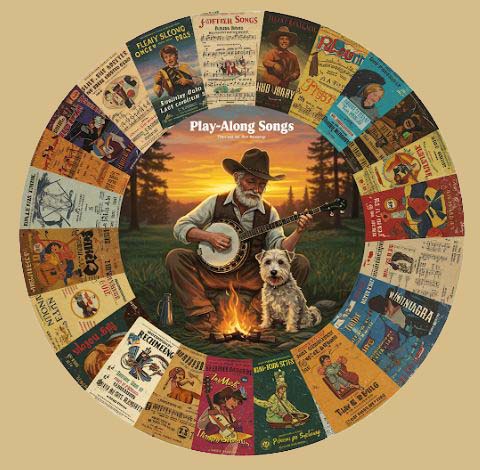-
- Jim Bottorff's
Banjo Page
- TIPS ON PLAYING
ALONG WITH THE SONGS

- Return to Home Page
- Return to Song
Catagories
- Go to Beginner's Songs
- Go to Instruction
Items
- Go to Easy Play-Along
Songs
- Go to Performer Links
page
- Website Search
- Go to bottom of this page
-
- Following are some tips
for listening, practicing, and playing along with the songs on
this website:
Play-Along Tips
-
- 1. Each song has an introduction
intended to get you into the song easily. Listen to the
bass and rhythm of the introduction and you should be able to
hear the tempo for the song. Lead-in melody notes for a
song will sometimes start before the introduction is finished.
Start strumming along with the song after the introduction
has finished. Most of the songs have a small pause at the end
of the introduction.
- Example Songs:
- Song with an 8 beat introduction
and no lead-in notes. (click
here)
- Song with an 8 beat introduction
and 2 lead-in notes. (click
here)
- Song in 3/4 waltz time with
a 6 beat introduction and no lead-in notes. (click
here)
Song in 3/4 waltz time with a 6 beat
introduction and 2 lead-in notes. (click
here)
- Many 3/4 waltz tunes have
a 12 beat introduction. (click
here)
- Song in 6/8 march time with
a 8 beat introduction and one lead-in note. (click
here)
-
- 2. Listening to the bass is important.
The bass notes are usually a simple steady beat with occasional
fill-in notes. Almost all the chord changes occur on a
bass beat. If you listen closely to the bass notes, the
chord changes should become easier to recognize.
3. The melody of each song is usually played in the higher octave
first time through, and the lower octave on the repeat. If
you use headphones, you can hear the separation of the high and
low melody. The high melody is on the right channel and
the low melody is on the left channel.
4. If you need to mute your banjo, try clipping two small spring-type
clothespins (wooden or plastic) onto each end of the bridge.
Placing a small strip of foam rubber or sponge behind the bridge
close to the tail piece also helps quiet the banjo. For amplified
performances, some musicians place a small towel under the head
between the bridge and truss rod. One quick way to get a soft
sound is to use a felt type ukulele pick, available at most music
stores.
5. Be careful with your body position (neck, shoulders, and back)
when practicing. Keep your head and eyes up, your shoulders
and back straight, and stay relaxed. Stand up and stretch often.
Try practicing in front of a mirror and watch your chord and
finger positions in the mirror, instead of looking down on your
banjo. Standing up and using a banjo shoulder strap can be a
refreshing change. Here is a Dave Marty video explaining how
to use a banjo strap (click
here).
6. Some midi player apps allow for changing the tempo and key
of songs as well as turning off various instrument tracks. Melody
players might like to turn off the song melody and play their
own melody along with the song accompaniment.
- Happy Picking and Strumming,
- Jim Bottorff
- Return
to top of this page